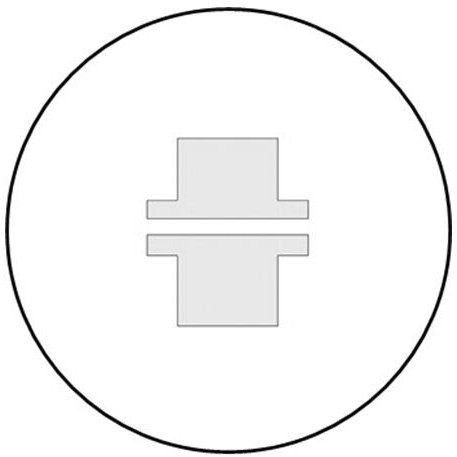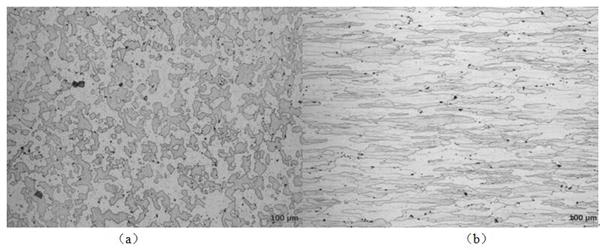A method for manufacturing a 7-series aluminum alloy profile for the upper girder of a civil aircraft wing
A technology for aluminum alloy profiles and alloy profiles, which is used in metal extrusion control equipment, manufacturing tools, metal extrusion and other directions, can solve problems such as large extrusion deformation resistance, serious casting cracking tendency, and aircraft delivery risks. The effect of enhancing lateral performance and reducing residual stress
- Summary
- Abstract
- Description
- Claims
- Application Information
AI Technical Summary
Problems solved by technology
Method used
Image
Examples
Embodiment 1
[0044] Step 1: Use semi-continuous casting to produce large-scale 7-series ingots with all indicators meeting the technical specifications, and perform homogenization annealing. Chemical analysis of the ingot revealed that the Si content was 0.04%, the Fe content was 0.08%, the Cu content was 2.24%, the Mg content was 2.0%, the Mn content was 0.01%, the Cr content was 0.0072%, the Zn content was 8.05%, and the Ti content was 0.045%. , Zr content 0.103%;
[0045] Step 2: Heat and heat-preserve the mold with a box-type mold heating furnace to ensure that the core of the mold is warm and the mold temperature is heated to 390°C;
[0046] Step 3: The set temperature of the extrusion barrel is 400°C, and the extrusion can only be carried out after the temperature reaches. ℃ / m; Put the heated ingot into the extrusion cylinder, put the ingot head side into the left and right double-hole molds, and perform reverse extrusion. The extrusion axis speed of reverse extrusion is 0.5mm / s , ...
Embodiment 2
[0050] Step 1: Use semi-continuous casting to produce large-scale 7-series ingots with all indicators meeting the technical specifications, and perform homogenization annealing. Chemical analysis of the ingot shows that the Si content is 0.05%, the Fe content is 0.09%, the Cu content is 2.38%, the Mg content is 2.1%, the Mn content is 0.01%, the Cr content is 0.0092%, the Zn content is 8.14%, and the Ti content is 0.032%. , Zr content 0.113%;
[0051] Step 2: Heat and heat-preserve the mold with a box-type mold heating furnace to ensure that the core of the mold is warm and the mold temperature is heated to 410°C;
[0052] Step 3: The temperature of the extrusion barrel is set at 420°C, and the extrusion can only be carried out after the temperature reaches the temperature. ℃ / m, put the heated ingot into the extrusion cylinder, put the ingot head side into the left and right double-hole molds, and perform reverse extrusion. The extrusion axis speed of reverse extrusion is 0.1...
Embodiment 3
[0056] Step 1: Use semi-continuous casting to produce large-scale 7-series ingots with all indicators meeting the technical specifications, and perform homogenization annealing. Chemical analysis of the ingot shows that the Si content is 0.05%, the Fe content is 0.09%, the Cu content is 2.38%, the Mg content is 2.1%, the Mn content is 0.01%, the Cr content is 0.0092%, the Zn content is 8.14%, and the Ti content is 0.032%. , Zr content 0.113%;
[0057] Step 2: Heat and heat-preserve the mold with a box-type mold heating furnace to ensure that the core of the mold is warm and the mold temperature is heated to 410°C;
[0058]Step 3: Set the temperature of the extrusion barrel to 420°C, set the temperature at the head end of the ingot to 430°C, and the temperature of the ingot from the head end to the tail end shows a gradient downward trend, and the temperature gradient is 20°C / m. The ingot is loaded into the extrusion cylinder, and the head end of the ingot is loaded into the l...
PUM
| Property | Measurement | Unit |
|---|---|---|
| tensile strength | aaaaa | aaaaa |
| yield strength | aaaaa | aaaaa |
| tensile strength | aaaaa | aaaaa |
Abstract
Description
Claims
Application Information
 Login to View More
Login to View More - R&D
- Intellectual Property
- Life Sciences
- Materials
- Tech Scout
- Unparalleled Data Quality
- Higher Quality Content
- 60% Fewer Hallucinations
Browse by: Latest US Patents, China's latest patents, Technical Efficacy Thesaurus, Application Domain, Technology Topic, Popular Technical Reports.
© 2025 PatSnap. All rights reserved.Legal|Privacy policy|Modern Slavery Act Transparency Statement|Sitemap|About US| Contact US: help@patsnap.com



